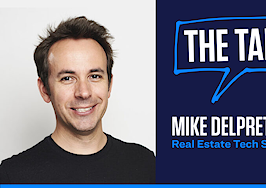This report is available exclusively to subscribers of Inman Intel, a data and research arm of Inman offering deep insights and market intelligence on the business of residential real estate and proptech. Subscribe today.
From the beginning, Intel has sought the expertise of people who know what’s making the markets move.
This week, Intel interviews an economist who believes he’s identified a significant risk that markets are missing — a banking risk entwined with real estate’s commercial sector.
K.C. Conway, a commercial real estate economist with Red Shoe Economics who spent five years within the Federal Reserve system, laid out his case in a phone interview with Intel that hundreds of the nation’s banks are exposed to high concentrations of commercial real estate — and disproportionate levels of risk.
His comments below are edited for length and clarity.
Intel: What’s your lay of the land for the banking uncertainty right now and how it impacts the commercial real estate sector?
Conway: I don’t think the Fed is connecting the dots. The Silicon Valley Bank failure is a perfect example of it. It’s a complete cluster in bank supervision. And I go back to the last rodeo, 2005 to 2010, when I was at the Atlanta Fed, with another complete failure in bank supervision.
If you think about it, in the bank regulatory world, they shouldn’t allow concentration risk to develop in the banks. The second thing is there never should have been the kind of issue on the deposits. Going back to 2003, in the regulatory world, we created this program called CDARS [the Certificate of Deposit Account Registry Service]. It is a program where an entity with, say, millions of dollars or billions of dollars could put all that money to work in one bank, but that bank is required to spread it out among 3,000 other banks so you don’t have more than $250,000 in one bank. The problem is, when you get to a Silicon Valley Bank, or some of those big banks, they don’t want to do that. They don’t want to tell a depositor that that option exists, because they want to hold all the deposits.
So we’ve lost all of the lessons that we’ve learned over 20 years. And the next shoe to drop is commercial real estate.
Trepp did a recent report that showed where half of all commercial real estate lending is held by banks today. And so, if these banks had done construction or loans, mortgage, Fannie, Freddie, multifamily loans that are fixed-rate, … and now we’re in a 7 percent interest rate environment, those are all overvalued.
And so if you look at these banks and how many have what they call CRE concentration risk — I look at two things. I look at the New York Fed data, and then I look at what’s called the Texas ratio. So it goes back to the 1980s. It’s maintained by LendingTree and a company called Deposit Accounts. And they calculate the Texas ratio on every bank and credit union in the country. And basically what that ratio is, is it’s a percentage of the bank’s riskiest loans as a percentage of their total deposits. And when that ratio gets anywhere near 10 percent, that’s 100 percent of a bank’s capital.
And we have hundreds of banks now that are well over that 10 percent ratio, suggesting these are undercapitalized or at-risk-of-failure banks. And my list shows here right now that we’ve got between 200 and 300 banks that are CRE concentrated with Texas ratios of 8, 9 or well over 10 percent — some as high as 19 percent.
So I think as we get close to May, the discovery’s gonna come in on those CRE-concentrated banks. And they’re largely going to be in the South and Southeast, because those are the community and regional banks that did a lot of commercial real estate lending, because you’ve got growth and population movement.
And so I’m very concerned that what we face in May, June and July is a restart of bank failures — and not just a couple of them like Silicon Valley or Signature, or the run on First Republic. I’m thinking we could see as many as 200 or 300 bank failures. And to put that number in perspective, during the Great Recession and the subprime mortgage crisis, we lost about 500 banks over a three-year period. So it’s a big number that I think is going to rattle the markets again in May, June and July.
I’m curious how much of this coming issue you see is due to the higher interest rate environment you mentioned — which played a role in the Silicon Valley Bank failure, for instance — versus, I think you’ve also mentioned, the impact of work-from-home on office commercial real estate.
So on the office side, the big risk is in the big urban markets: New York, San Francisco, L.A., Philadelphia. They have the big high-rise markets. And more of those big office building loans are in very big trouble. Their values have already dropped 20 to 30 percent, and probably have another 20 to 40 percent to go. I’m worried about those the most. Those are held more by big banks, or they’re held by life companies that want to put big chunks of dollars to work in one asset at a time.
The regional banks didn’t tend to do a lot of big urban office. That went to the big-dollar money, the big banks, the securitization arena. But they did an awful lot in the suburbs. And so the extent they’re sitting on a lot of suburban office portfolio that is also being affected by work-remote, or that were construction loans started right before COVID, they have not done a lot of the re-fi risk analysis to see is a building that cost $300 per square foot to build worth $300 per square foot.
I think the bigger risk is in the construction risk — whether it’s multifamily, retail, even the industrial stuff — where what we’re seeing is as the interest rates have risen, so too have the cap rates. And none of this stuff has been repriced, assuming instead of 4 and 5 percent cap rates, we value them at a 7 or 8 percent cap rate. And that alone means about a 25 percent drop in value. So the banks have not done a good job at looking at re-fi risk from the interest rates, any more than the Fed did on Silicon Valley Bank, or the rest of the banking industry.
If the Fed continues on a rate-hiking mode, they are just going to exacerbate the banking crisis. And if they don’t stay on the rate-hiking mode, they’re communicating to the rest of the world, “We’re really not serious about inflation.” So either way, it’s a bad situation to be in.
How do you think this plays out for these banks that are exposed to a lot of commercial real estate?
I don’t have confidence in the Fed that they’re going to do the smart and right thing. They don’t know what they don’t know anymore.
The Fed should be sitting down with every CRE-concentrated bank that’s at risk. Just imagine, if you’re sitting on 300 percent real estate of your capital, and that’s going to drop by 25 to 50 percent, you have no capital. You need to raise capital. So those 300-plus banks, they ought to be sitting down with and making sure that every depositor that has more than $250,000 on deposit, that they spread that around right away into the CDARS program so that we don’t have a hit to the FDIC fund, and that those deposits are insured without the [government] having to step in and guarantee every deposit.
And where this really becomes a risk concern is many small- [and] medium-sized businesses, even big businesses, they accumulate their payroll in these banks. And it’s going to be well above $250,000. So what happened in Silicon Valley, the real risk was that all of these companies that had their payroll accumulated, all the payrolls were wiped out if the FDIC didn’t backstop it. We can avoid that right now by the Fed doing their job and working with bank supervision to make sure that these CRE-concentrated programs have all deposits over $250,000 spread into the CDARS program.
So there’s a lot of intervention that we can do to make this not so bad. We still have over 5,000 banks, and more than that in credit unions. So we have enough institutions to still provide liquidity in this system.
But if the Fed doesn’t do its job and connect the dots, they can create a market panic. And what we saw in Silicon Valley Bank — and what’s different today than 2008 or 2009 — is the intensity of social media. They can create literally in hours, if not minutes, a run on a bank. And that’s a lesson the Fed hasn’t learned yet. It has no idea how to manage that risk.













